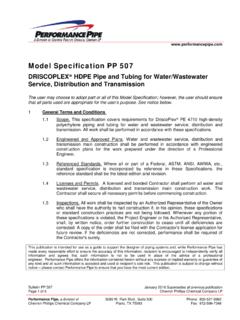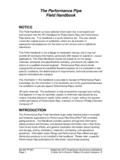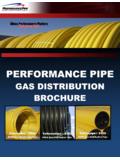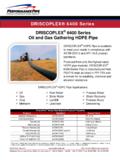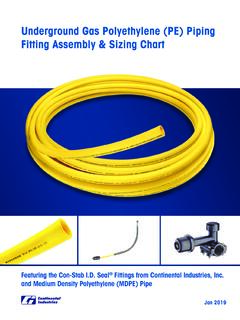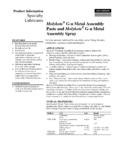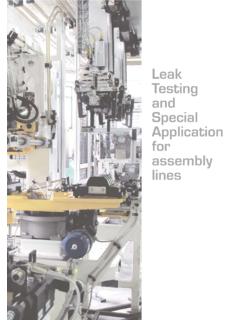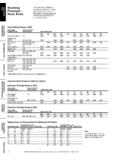Transcription of www.performancepipe.com Technical ... - HDPE Pipe & Fitting
1 Bulletin: PP 811-TN July 2006 Supersedes all previous publications Page 1 of 7 2003-2006 Chevron Phillips Chemical Company LP Note PP 811-TN PE Flange Connections Flange Connection Flanged joints are made using a DriscoPlex Flange Adapter that is fused to the pipe then joined to a mating flange adapter or a mating appurtenance flange. A back-up ring is fitted behind the flange adapter s sealing surface flange as shown in Figure 2-1 and bolted to the mating flange. DriscoPlex Flange Adapters have a serrated sealing surface. At lower pressure, typically 100 psi or less, a gasket is usually not required. At greater pressure, the serrations help hold the gasket in place. The back-up ring is required for polyethylene flange joints in order to develop uniform pressure around the entire sealing surface.
2 Without a back-up ring, a polyethylene flange will leak between the bolts. Standard back-up rings are convoluted ductile iron with AWWA C207 150 lb drilling. Other available back-up ring materials are steel, primer-coated steel; epoxy coated steel, stainless steel or fiberglass. In below ground service, coatings and cathodic protection may be needed to protect metal back-up rings from corrosion. One edge of the back-up ring bore must be radiused or chamfered. This edge fits against the back of the sealing surface flange. Service pressure ratings for back-up ring designs and materials will vary. Consult the back-up ring supplier for the maximum recommended rating. The service pressure rating for the back-up ring should meet or exceed the service pressure of the pipe.
3 Typically, back-up rings are ANSI Class 125 for gravity applications, ANSI Class 150 or AWWA C207 for pressures up to 267 psi (200 psi for 20 to 24 sizes), and ANSI Class 300 for higher pressure. Flange adapters are long enough so that they can be clamped in a fusion machine like a pipe end. The back-up ring is fitted to the flange adapter before fusion, so external fusion bead removal is not required. Figure 2-1 Flange Adapter and Back-Up Ring NOTICE. This publication is for informational purposes and is intended for use as a reference guide. It should not be used in place of the advice of a professional engineer. This publication does not contain or confer any warranty or guarantee of any kind. Performance Pipe has made every reasonable effort towards the accuracy of the information contained in this publication, but it may not provide all necessary information, particularly with respect to special or unusual applications.
4 This publication may be changed from time to time without notice. Contact Performance Pipe to ensure that you have the most current edition. Bulletin: PP 811-TN July 2006 Supersedes all previous publications Page 2 of 7 2003-2006 Chevron Phillips Chemical Company LP Gasketing Typically, a flange gasket is not necessary between polyethylene flanges at 100 psi or less. Gaskets may be needed for higher pressures or for connections between polyethylene and non-polyethylene flanges. Gasket materials should be chemically and thermally compatible with the internal fluid and the external environment, should be of appropriate hardness, thickness, and style, and should be recommended by the gasket manufacturer for use with polyethylene pipe flanges. Elevated temperature applications may require higher temperature capability.
5 Gasket materials are not limited to those shown in Table 2-1. Other materials may also be suitable. Gasket thickness and durometer are typically 1/8"-3/16" (3-5 mm) and 55-75 Type A hardness per ASTM D2240, respectively. Too soft or too thick gaskets may blow out under pressure. Overly hard gaskets may not seal. When joining mating polyethylene flange adapters, cut gaskets to an ID equal to the polyethylene pipe ID. When joining polyethylene to other materials cut gaskets to the larger of the two ID s, which will generally be the ID of the non-polyethylene pipe material. (Using standard, off the shelf cut gaskets may reduce the gasket sealing area and the effectiveness of the seal.) Figure 2-2 Flange Gasket Styles *Consult Gasket Supplier for specific recommendation.
6 Common gasket styles are full-face or drop-in. Full-face style gaskets are usually applied to larger sizes, because flange bolts will hold a flexible gasket in place while Fitting the components together. Drop-in style gaskets are usually applied to smaller pipe sizes. See Figure 2-2. Flange Bolting Mating flanges are usually joined together with hex head bolts and hex nuts, or threaded studs and hex nuts. Generally, hex head and stud bolts are SAE Grade 2 or ASTM A307 Grade B when used to joining flanges with rubber gaskets. When using non-rubber gaskets or when using Class 300 back-up rings, higher strength bolts may be required to provide sufficient clamping force to seal the gaskets. Check with the gasket supplier.
7 Corrosion resistant materials should be considered for underground, underwater or other corrosive environments. Flange bolts are typically sized 1/8" smaller than the bolthole diameter. Flat washers should be used between the nut and the back-up ring. Table 2-1 Typical Gasket Materials Gasket Material Generally Suitable Chemicals* Brown Rubber (cloth reinforced) Water (hot or cold) Neoprene Water, weak acids Nitrile Water, oils SBR (Red Rubber) (cloth or wire reinforced) Air, water PTFE gasket with micro-cellular layers outside & hard center Strong caustics, strong acids, and hydrocarbons Hard, compressed Nitrile bound Aramid fiber Water, oils, aliphatic hydrocarbons Bulletin.
8 PP 811-TN July 2006 Supersedes all previous publications Page 3 of 7 2003-2006 Chevron Phillips Chemical Company LP 2-3 Bolt Length parameters Flange bolts must span the entire width of the flange joint, and provide sufficient thread length to fully engage the nut. (See Figure 2-3.) Dimensions for DriscoPlex Flange Adapters, and Back-Up Rings are found in Performance Pipe product literature and are located on Performance Pipe s web site ( ) on the Technical Library page at the link Fittings . The minimum bolt length required for joining two DriscoPlex Flange Adapters may be determined using the following: BgfbBdTTTL+++=)(2 (2-1) Where LB = minimum bolt length, in Tb = back-up ring thickness, in Tf = flange adapter flange thickness, in Tg = gasket thickness, in db = bolt diameter, in The LB term provides for a standard flat washer under the nut and full thread engagement into a standard nut.
9 Bolt length should be rounded up to the nearest standard bolt length. Rounding down may result in bolts shorter than the required minimum length. A gasket may or may not be present so gasket thickness should be included only when a gasket is used. If threaded studs are used, then nuts and washers are installed on both sides. For two DriscoPlex Flange Adapters, stud length is determined by: gBfbSTdTTL+++=)(2 (2-2) Where terms are as above and LS = minimum stud length, in As with bolts, stud length should be rounded up to the nearest standard length. Table 2-2 Flange Dimensions (Inch Sized) ANSI Class 1501 IPS Pipe Size Flange OD Bolt Circle Diameter Bolt Hole Diameter No. of Bolts 1-1/2 4 2 4 3 4 4 8 6 8 8 8 10 12 12 12 14 12 16 16 18
10 16 20 20 22 20 24 20 1 ASME/ANSI - 1996 Pipe Flanges And Flanged Fittings Bulletin: PP 811-TN July 2006 Supersedes all previous publications Page 4 of 7 2003-2006 Chevron Phillips Chemical Company LP Tightening Bolt tightening torque values are given in Table 2-3 and are typically sufficient for obtaining a seal. However, bolts should be tightened to the gasket manufacturer s recommended torque for the selected gasket and the particular application conditions. Generally, rubber gaskets require less assembly stress (contact stress) than gaskets made from other materials such as hard compressed non-asbestos materials.
